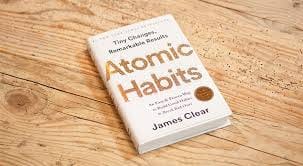 A daily 1% improvement can make you 37 times better by the end of the year. This simple truth is the foundation of our atomic habits review. James Clear’s approach to habit formation has resonated with millions of readers worldwide.
A daily 1% improvement can make you 37 times better by the end of the year. This simple truth is the foundation of our atomic habits review. James Clear’s approach to habit formation has resonated with millions of readers worldwide.
Many self-improvement books push for big changes. Clear takes a different path. He breaks down habit formation into four basic laws that make habits obvious, attractive, easy, and satisfying. The book presents a tested framework where small, consistent actions create remarkable changes through the habit loop: cue, craving, response, and reward.
This detailed summary of Atomic Habits will help you discover practical strategies like the Two-Minute Rule and temptation bundling. These techniques have helped countless readers build lasting habits. They’ve helped me too. The focus shifts from what we want to achieve to who we want to become.
The Core Message of Atomic Habits
The math behind Atomic Habits is simple yet powerful: small improvements add up to amazing results over time. A person who improves by 1% each day becomes thirty-seven times better in just one year [1]. In spite of that, this works both ways – dropping by 1% each day leaves you with almost nothing to show by year’s end [1].
Small changes compound
Small wins work just like compound interest in your bank account. Something that starts tiny, good or bad, grows into something much bigger [1]. The sort of thing I love about this idea is how it goes against what we usually think – we tend to look for big changes and miss the power of small, daily improvements.
Clear shows us that you don’t need huge changes to succeed. So, these tiny improvements create amazing differences as time passes [1]. The secret is simple: habits are the compound interest of self-improvement [2]. Every small choice you make creates waves that shape your future, even if it seems tiny right now.
Systems over goals
Clear’s philosophy highlights a key difference between systems and goals. Goals point the way, and systems guide our progress [3]. I found that through my own journey that results rarely come from the goals we set – they come from the systems we follow.
Here’s why systems win over goals:
- Goals create a “yo-yo effect” of motivation, making long-term progress difficult [4]
- Goals reduce current happiness by teaching us to postpone satisfaction [4]
- Goals suggest control over things we cannot influence [4]
The answer lies in focusing on the process instead of obsessing over a goal. Systems help remove the pressure to see instant results. This matches Clear’s powerful quote: “You do not rise to the level of your goals. You fall to the level of your systems” [4].
Good systems need feedback loops that track different elements without trying to predict everything [4]. This method lets you improve steadily without the weight of massive goals. More importantly, looking back at progress instead of always forward helps you appreciate how far you’ve come, rather than always chasing tomorrow [4].
Identity-Based Habit Formation
“Every action you take is a vote for the type of person you wish to become.” — James Clear, Author of Atomic Habits and expert on habit formation
True transformation starts with identity, not actions. This forms the foundation of lasting behavior change. I found that focusing on identity-based habits instead of outcome-based goals creates a strong base for permanent change [5].
Becoming your ideal self
A simple yet powerful question starts your trip to becoming your ideal self: “Who do you want to be?” [6]. The focus moves to embodying the traits of the person you want to become rather than what you want to achieve. Research shows that habits become automatic and effortless when they line up with our self-image [7].
You need clarity about your desired identity. To name just one example, instead of setting a goal to lose weight, you might say, “I am someone who prioritizes health.” This viewpoint makes healthy choices feel natural and true to who you are [5].
Belief systems
Our long-term behavior patterns stem from our beliefs about ourselves. Every action we take proves the type of person we believe ourselves to be [8]. Studies indicate that habits form more easily when they’re based on personal values rather than what others want from us [7].
The science backs this approach. Research shows habits become more automatic as they blend into our self-image [9]. These identity-aligned behaviors also take less mental effort, which helps them last longer [10].
Identity reinforcement
Identity and habits work together. Our identity shapes our habits, and our habits reshape our identity [11]. This creates a feedback loop where each action strengthens our self-image. Studies show that habits become automatic around 66 days after starting daily practice [7].
To strengthen your new identity:
- Make small, manageable changes that show evidence of your new identity
- Stay consistent rather than perfect
- Join groups that share your desired identity’s values
- Use positive self-talk and identity-based affirmations [10]
The success of identity-based habits comes from their power to create lasting change through internal transformation. Your new behaviors become natural and effortless as your new identity grows stronger through consistent action [7]. Without doubt, this approach offers a better path to personal growth than just relying on willpower or motivation.
Breaking Down Bad Habits
Breaking unwanted habits needs us to understand what drives our behavior. Research shows that most bad habits come from two main sources: stress and boredom [12]. The original step to create lasting change is to recognize why it happens.
Identifying triggers
The science of habit formation shows that triggers fall into five distinct categories [13]:
- Location-based cues
- Time-specific prompts
- Emotional states
- Social situations
- Immediately preceding actions
These triggers activate our behavior patterns without us even knowing [14]. Studies show that habits continue without much thought once they form [14]. Tracking these triggers for three to five days helps us spot patterns that lead to unwanted behaviors [13].
Environment design
Our physical spaces shape our daily choices. Research shows that changing our environment is one of the quickest and easiest ways to change habits [1]. Our surroundings affect our behaviors by a lot, yet we rarely notice their influence [1].
Making bad habits harder while making good ones easier works well [2]. To name just one example, someone reduced their smoking by putting a couch in front of their balcony door [15]. Getting rid of junk food at home makes it harder to overeat [2].
Replacement strategies
Just trying to stop a bad habit doesn’t work well. Research backs up that switching unwanted behaviors with positive alternatives gets better results [16]. Success comes from finding new actions that give us the same benefits as the old habit [12].
A predetermined plan helps when triggers for unwanted habits show up [17]. This might include:
- Calling a friend
- Taking a walk
- Practicing breathing techniques
- Engaging in a productive activity
Replacement strategies work better when combined with Clear’s principle of making bad habits invisible, unattractive, difficult, and unsatisfying [18]. This all-encompassing approach tackles both the environmental and psychological aspects of habit change.
Social Impact on Habit Formation
Social connections shape our habits more powerfully than we realize. Research shows that our social networks substantially influence everything from exercise habits to alcohol consumption patterns [19]. The effect of relationships on our behavior goes way beyond the reach and influence of mere motivation.
Peer influence
The science behind peer influence reveals the sort of thing I love about habit formation. Studies show that another peer’s presence can alter the brain’s reward response [20]. We observed this influence through social norms and unwritten rules that guide behavior [21]. The effect becomes stronger during adolescence as people seek social acceptance [22].
Peer influence works through multiple channels. People who exhibit specific habits naturally make us mirror their behaviors [23]. Our brains create this mirroring effect because they seek compatibility and minimize differences with others [22]. This tendency can work both ways – it supports positive changes or reinforces negative patterns.
Community support
A supportive community creates the framework needed to change habits in eco-friendly ways. Research shows that strong social connections protect health and extend life [19]. Community support demonstrates its power in several key ways:
- Accountability partnerships increase commitment to habits
- Shared experiences provide motivation and encouragement
- Group dynamics create positive peer pressure
- Community feedback helps maintain consistency
Studies confirm that joining groups focused on specific habits substantially increases success rates [24]. To cite an instance, fitness communities help members stay committed to health goals, while yoga groups support consistent practice patterns [24]. Communities provide tools, guidance, and assistance throughout the trip of building new habits.
Community support does more than just encourage. Research shows that strong, healthy relationships affect both mental and physical well-being [19]. Communities offer rewards when members meet certain goals and create additional motivation for habit maintenance [24]. This mix of support and recognition builds a powerful environment for positive change.
Social support becomes most valuable during challenging times. Community members share experiences and provide practical solutions based on their own successes and failures when obstacles arise [24]. This collective wisdom helps people navigate difficulties and maintain momentum in habit formation.
Habit Stacking Techniques
You can build better habits more easily through habit stacking – a method that connects new behaviors to existing ones [25]. This technique uses your brain’s natural tendency to build strong neural networks. This makes habit formation automatic and long-lasting [4].
Creating triggers
Our brains naturally form reliable connections between behaviors we already practice [26]. We started by identifying anchor moments – existing habits that work as reliable triggers for new behaviors [26]. Research shows that your environment has more impact than willpower alone when you’re trying to establish new habits [5].
To create effective triggers, the process involves:
- Identifying current daily habits that occur consistently
- Selecting new behaviors that take less than five minutes
- Creating specific, time-bound connections
- Ensuring the combination follows a logical sequence [3]
The power of this method lies in its specificity. Instead of a vague goal like “meditate more,” you might decide “When I finish my morning coffee, I will meditate for two minutes” [4]. Studies show that your chances of success increase when a new habit connects tightly to a specific cue [4].
Linking behaviors
Habit stacking works because it uses parts of our lives that are already automatic and reliable [27]. The established habit becomes a dependable cue for the new action when we connect new behaviors to existing ones [27]. Research suggests that building a habit can take anywhere from 18 to 200 days [27].
The process works best when you follow these principles:
- Choose current habits that occur consistently
- Select new behaviors that improve your life
- Ensure the whole routine takes less than 30 minutes
- Follow a checklist to maintain consistency [3]
This technique reduces mental effort effectively. You just need to follow your checklist instead of thinking about each individual habit [3]. The method works well especially when you have new habits that feel natural with something you already do [26].
The science behind this method shows that consistency of practice matters more than duration [26]. This insight has led to simple formulas like “After/Before [CURRENT HABIT], I will [NEW HABIT]” [4]. This organized approach creates simple rules that guide future behavior and makes habit formation systematic and achievable [4].
Modern Challenges to Habit Building
Modern life throws unique roadblocks in our path to building lasting habits. Research reveals that 91% of individuals lose sleep due to binge-watching, while 75% stay up late shopping online [28]. These numbers paint a clear picture of how digital age challenges can derail our plans for positive change.
Digital distractions
Digital devices have become a major threat to forming good habits. Studies show that 87% of people keep smartphones within arm’s reach in their bedrooms [28]. This constant connection creates an environment where midnight scrolling and late-night entertainment become tempting habits that hurt both sleep quality and daily routines.
These distractions do more than just interrupt us. Research shows that switching between tasks because of digital interruptions reduces productivity and increases mistakes [29]. The endless stream of notifications and information creates a cycle where we can’t focus on building better habits.
Information overload
The amount of information created every two days now equals everything produced from civilization’s beginning until 2003 [11]. This data tsunami makes it hard to form new habits. Research points out that information overload is one of the biggest stressors, affecting 22.5% of participants in a representative study [11].
Information overload shows its effects in several ways:
- Increased strain and burnout
- Reduced job satisfaction
- Major performance losses
- Poor decision-making quality [11]
Time management
Time management is vital to curb these modern challenges. Research proves that multi-tasking, despite what many believe, actually hurts productivity [30]. People who regularly multi-task often struggle to maintain focus and concentration.
Studies suggest well-laid-out time management strategies work best. You should schedule about three-fourths of your day and leave room for creative activities and unexpected tasks [30]. On top of that, research backs the “big frog first” principle – tackle the toughest tasks early when your mind is fresh.
Building habits in the digital age needs new strategies. Setting boundaries with technology helps – turn off notifications during focus time and create device-free zones [28]. Research shows that these environmental barriers work better than willpower alone [30].
The secret lies in creating systems that work with these modern challenges while keeping habits consistent. Studies reveal that habits become automatic after about 66 days of daily practice [31]. This timeline helps set realistic goals when building new habits in our distraction-filled world.
Practical Implementation Steps
Success in habit formation depends on well-laid-out implementation. Research indicates that establishing a routine takes anywhere from 18 to 245 days [6]. This highlights why proper planning becomes essential to create lasting change.
Daily routine design
A good routine design begins with understanding your natural patterns. Studies show that people with good health typically follow highly structured behaviors [6]. The secret lies in creating a system that fits naturally into your daily life.
Here’s how to design an effective routine:
- Start with one or two changes at a time
- Build around existing stable behaviors
- Allow flexibility for disruptions
- Create specific time-based triggers [6]
The goal isn’t perfect adherence but steady progress. Research demonstrates that occasional non-adherence won’t derail progress. This makes it vital to maintain realistic expectations [6]. Health professionals now recommend helping patients develop routines gradually instead of pushing for immediate lifestyle overhauls [6].
Progress tracking
Progress tracking forms the foundation of successful habit formation. Studies reveal that people who maintain daily food logs lose twice as much weight as those who don’t [32]. Tracking provides visual proof of progress and builds motivation through evidence of improvement.
These tracking methods work best:
- Calendar-based tracking with daily marks
- Digital habit tracking apps
- Spreadsheet monitoring
- Paper-based templates [33]
Manual tracking works best when limited to three or four important habits [32]. People who record their progress right after completing a habit strengthen the connection and improve consistency [32]. This immediate feedback loop reinforces positive behaviors and helps maintain momentum.
Adjustment methods
The path to habit formation isn’t linear. Research shows that complex routines take much longer than the average 66-day period observed for simple behaviors [6]. Understanding this variability helps set realistic expectations and allows adjustments as needed.
Key points to think about when making adjustments:
- Breaking complex habits into smaller segments
- Tailoring approaches to individual circumstances
- Planning for routine disruptions
- Creating backup strategies [6]
Long-term routine establishment matters more than short-term perfection [6]. This point of view helps maintain progress even during setbacks. Research confirms that missing one day doesn’t affect long-term success if you return to the habit quickly [7].
Routines sometimes need modification based on changing circumstances. Studies indicate that forming certain habits works better during well-rested periods [9]. This insight shows the importance of timing in habit formation and the need for strategic adjustments.
The science of implementation emphasizes starting small and building complexity gradually. Research shows that adding too many changes at once often leads to behavior relapse [6]. Adding one or two modifications at a time creates stronger foundations for lasting change.
Long-Term Habit Maintenance
“The secret to getting results that last is to never stop making improvements.” — James Clear, Author of Atomic Habits and expert on habit formation
People need different strategies to keep habits going than to form them. Studies show 40-60% of people fall back into old patterns during their habit-building experience [34]. This makes long-term maintenance strategies vital.
Preventing relapse
The science behind keeping habits shows three stages of relapse: emotional, mental, and physical [35]. People become vulnerable to emotional relapse through stress and poor self-care. A mental relapse follows as they struggle between sticking to new habits and going back to old ones [35].
Research points to these strategies that help prevent relapse:
- Track your habits regularly
- Set up helpful reminders in your environment
- Build a strong support system
- Learn ways to handle stress [36]
People who stick to well-laid-out routines are more likely to keep their habits long-term [37]. The key is to start preventing relapse well before temptation hits.
Growing with your habits
Habits change as life does. People who keep habits long-term know how to adjust them to fit their changing lives [5]. This growth happens in three main ways:
Self-directed neuroplasticity lets you rewire brain patterns through active reflection [5]. You can adapt habits while keeping their benefits. Writing down your thoughts right after activities helps connect feelings with actions and makes the habit loop stronger [5].
Your environment shapes your behavior patterns more than willpower alone [38]. Small changes to your physical space can make a big difference in how you act.
Support systems should grow with your habits. People who join support groups regularly get accountability, learning opportunities, and understanding from peers [34]. This social aspect helps habits stick.
Getting better every day
Small daily improvements work better than big changes. A 1% daily improvement adds up to amazing results over time [39]. This approach lasts longer than trying to change everything at once.
Research shows these factors help you improve steadily:
- Look back to measure progress instead of looking forward
- Cut out mistakes rather than adding complexity
- Create ways to check and adjust your behavior [39]
The best improvements often come from simple solutions we overlook [39]. You’ll make more progress by doing fewer things wrong than by trying to do more things right [39].
Habits work best when they become part of your daily life. It takes about 66 days of daily practice before a habit becomes automatic [31]. This timeline helps set real expectations for making habits stick.
Setbacks happen even with good planning. Missing one day won’t hurt your long-term success if you get back on track quickly [5]. This knowledge helps keep momentum through brief disruptions.
The science shows that habits become more automatic as they become part of who you are [40]. This connection between habits and identity makes them more likely to stick.
Your approach to maintaining habits should match your personal situation [41]. The best strategies combine smart environment design, social support, and regular tracking [8]. This mix helps habits stay relevant and sustainable.
Conclusion
Building lasting habits just needs more than motivation – you need a systematic approach based on science and self-awareness. My trip with Atomic Habits taught me that success comes from small, consistent improvements rather than dramatic changes.
Your path to change starts with identity-based shifts, backed by systems that work and smart environment design. Goals matter less than your daily actions and proper tracking to create lasting progress. My experience shows that habit stacking techniques combined with strong social support boost success rates by a lot.
Digital distractions and information overload challenge our habit-building efforts, but practical strategies help overcome these obstacles. Note that missing one day won’t derail your progress – consistency matters more than perfection. Science proves that tiny improvements add up each day and lead to remarkable changes over time.
Atomic habits’ true strength isn’t in quick wins but in knowing how to reshape our identity through consistent action. Daily behaviors that line up with who we want to become naturally lead to lasting change.
FAQs
Q1. What are the key principles of Atomic Habits? The four fundamental laws of Atomic Habits are: make it obvious, make it attractive, make it easy, and make it satisfying. These principles help in creating good habits and breaking bad ones by focusing on small, consistent changes that compound over time.
Q2. How long does it typically take to form a new habit? While the commonly cited 21-day rule is a myth, research suggests that habit formation can take anywhere from 18 to 254 days, with an average of about 66 days. The time varies depending on the complexity of the habit and individual circumstances.
Q3. What is the “1% rule” in Atomic Habits? The 1% rule suggests that small, incremental improvements of just 1% each day can lead to significant results over time. This principle emphasizes the power of consistent, tiny changes in creating substantial long-term progress.
Q4. How can I maintain habits in the face of modern distractions? To maintain habits amidst modern distractions, try implementing strategies like setting boundaries with technology, creating device-free zones, and using structured time management techniques. Additionally, focus on designing your environment to support your desired habits and reduce exposure to triggers for unwanted behaviors.
Q5. What role does identity play in habit formation? Identity plays a crucial role in habit formation. Instead of focusing solely on outcome-based goals, Atomic Habits emphasizes becoming the type of person who naturally performs the desired behaviors. By aligning your habits with your desired identity, you can create more sustainable and meaningful changes in your life.










